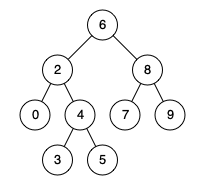[Swift]LeetCode235. 二叉搜尋樹的最近公共祖先 | Lowest Common Ancestor of a Binary Search Tree
阿新 • • 發佈:2019-01-01
Given a binary search tree (BST), find the lowest common ancestor (LCA) of two given nodes in the BST.
According to the definition of LCA on Wikipedia: “The lowest common ancestor is defined between two nodes p and q as the lowest node in T that has both p and q as descendants (where we allow a node to be a descendant of itself).”
Given binary search tree: root = [6,2,8,0,4,7,9,null,null,3,5]

Example 1:
Input: root = [6,2,8,0,4,7,9,null,null,3,5], p = 2, q = 8 Output: 6 Explanation: The LCA of nodes2and8is6.
Example 2:
Input: root = [6,2,8,0,4,7,9,null,null,3,5], p = 2, q = 4 Output: 2 Explanation: The LCA of nodes2and4is2, since a node can be a descendant of itself according to the LCA definition.
Note:
- All of the nodes' values will be unique.
- p and q are different and both values will exist in the BST.
給定一個二叉搜尋樹, 找到該樹中兩個指定節點的最近公共祖先。
百度百科中最近公共祖先的定義為:“對於有根樹 T 的兩個結點 p、q,最近公共祖先表示為一個結點 x,滿足 x 是 p、q 的祖先且 x 的深度儘可能大(一個節點也可以是它自己的祖先)。”
例如,給定如下二叉搜尋樹: root = [6,2,8,0,4,7,9,null,null,3,5]

示例 1:
輸入: root = [6,2,8,0,4,7,9,null,null,3,5], p = 2, q = 8 輸出: 6 解釋: 節點2和節點8的最近公共祖先是6。
示例 2:
輸入: root = [6,2,8,0,4,7,9,null,null,3,5], p = 2, q = 4 輸出: 2 解釋: 節點2和節點4的最近公共祖先是2, 因為根據定義最近公共祖先節點可以為節點本身。
說明:
- 所有節點的值都是唯一的。
- p、q 為不同節點且均存在於給定的二叉搜尋樹中。
遞迴
1 /** 2 * Definition for a binary tree node. 3 * public class TreeNode { 4 * public var val: Int 5 * public var left: TreeNode? 6 * public var right: TreeNode? 7 * public init(_ val: Int) { 8 * self.val = val 9 * self.left = nil 10 * self.right = nil 11 * } 12 * } 13 */ 14 class Solution { 15 func lowestCommonAncestor(_ root: TreeNode?, _ p: TreeNode?,_ q: TreeNode?) -> TreeNode? { 16 if root == nil {return nil} 17 if root!.val > max(p!.val,q!.val) 18 { 19 return lowestCommonAncestor(root!.left, p, q) 20 } 21 else if root!.val < min(p!.val, q!.val) 22 { 23 return lowestCommonAncestor(root!.right, p, q) 24 } 25 else 26 { 27 return root 28 } 29 } 30 }
